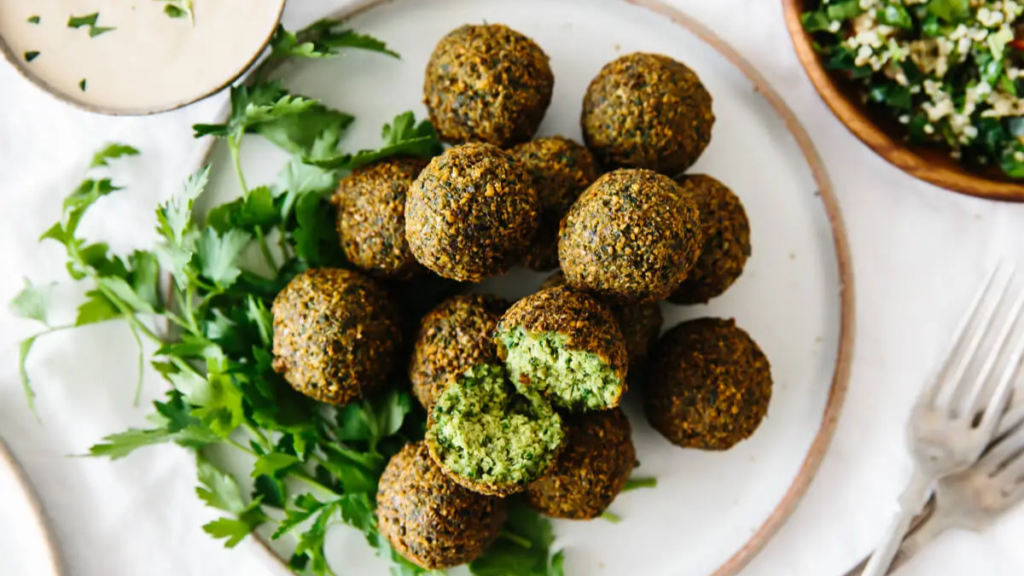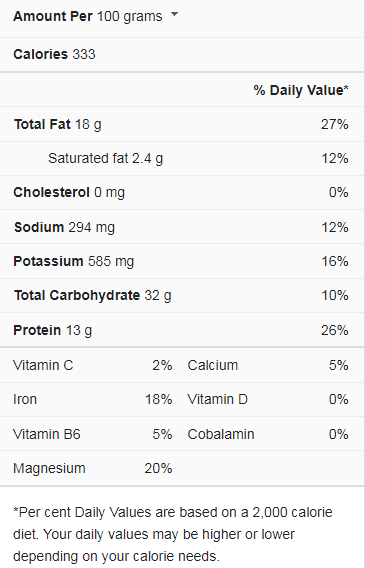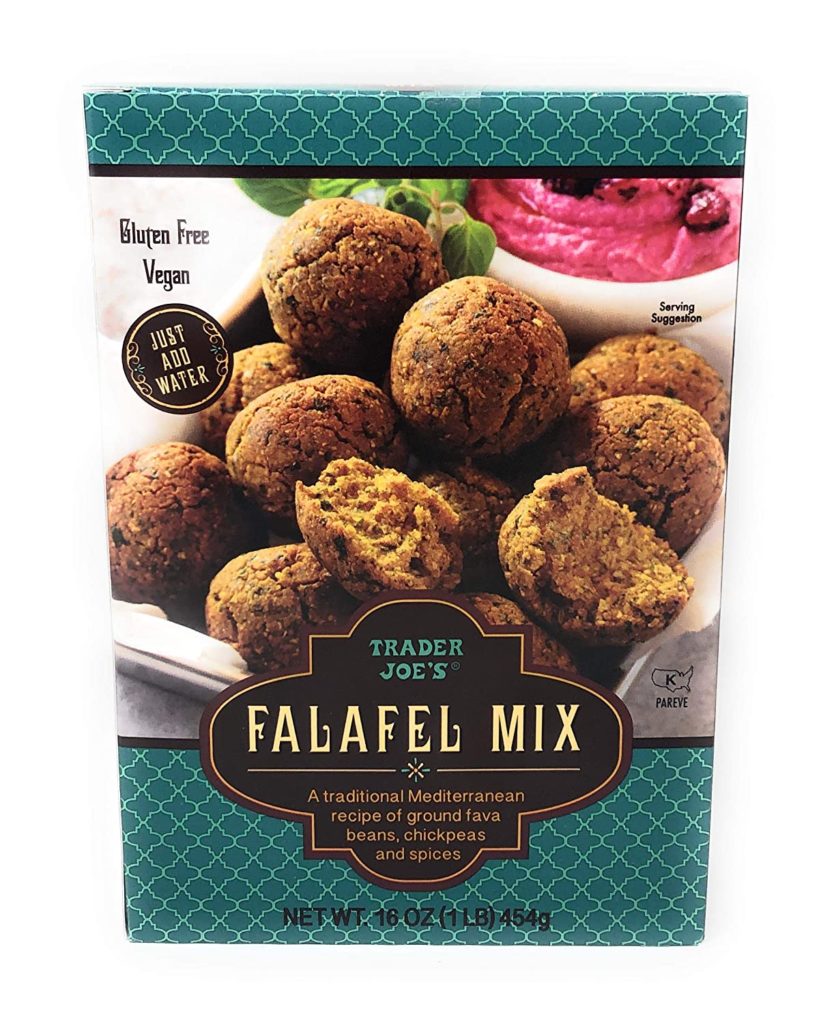Falafel is a Middle Eastern dish that is particularly popular among vegans and vegetarians. It is made out of deep-fried patties prepared from a mixture of chickpeas (or fava beans), herbs, spices, onion, and dough. Falafel can be eaten on its own, although it’s usually served in a pita pocket, flatbread, or as part of a meze (a collection of appetizers). Despite its popularity and abundance of nutritional components, many people question whether it is a healthy dish.
It’s frequently deep-fried in oil, significantly increasing calorie and fat content. Obesity, heart disease, diabetes, and cancer have all been linked to eating deep-fried foods regularly. Furthermore, some people may be allergic to sesame seeds found in Falafel or served with it.
Falafel Nutrition Facts
Falafel Nutrition Facts are as follows:
Health Benefits of Falafel
Falafel has several properties that may benefit your health in various ways. To begin with, it’s high in fiber and plant-based protein, two nutrients that work together to keep you satiated for longer. Fiber and protein have been shown to lower hunger hormones such as ghrelin while increasing fullness hormones such as cholecystokinin, glucagon-like peptide- and peptide.
Low fat
Legumes are low in saturated fat because they are plant-based. For a 2,000-calorie diet, experts recommend limiting saturated fat to 20 grams daily.
Protein-rich
Protein and cholesterol are both abundant in legumes. As a result, beans can be used as a meat alternative.
Dietary fiber is beneficial
According to experts, fiber intake should range from 25 to 38 grams per day, and fiber should be obtained through meals rather than supplements. Legumes have roughly 7 to 9 grams of fiber per ounce.
Lower your cholesterol.
You can lower your total and low-density lipoprotein (LDL) or “bad” cholesterol levels by eating legumes for more than three weeks. In research, one group of persons with type 2 diabetes replaced red meat with legumes three times a week. Their LDL cholesterol, triglycerides, fasting blood glucose, and insulin levels decreased.
Reduce your blood pressure
Consuming nutrient-dense beans may also aid in blood pressure reduction. According to several studies, people’s blood pressure dropped dramatically after eating 1 cup of beans each day for ten weeks.
The Glycemic index is low
Foods with a low glycemic index release glucose gradually and continuously, and this assists you in maintaining blood sugar management. The glycemic index of legumes is usually between 10 and 40.
Calorie Count
Low Falafel has a low-calorie count compared to other fried foods. Similar foods like shawarma and doner kebabs all feature high-calorie meats; however, Falafel is prepared from chickpeas, which have a far lower calorie content.
Fiber and protein-rich
Chickpeas, like other legumes such as lentils and beans, are high in fiber and protein, which provide a variety of health advantages such as heart health, muscle repair and development, weight control, digestive health, and more.
Vitamins and minerals abound.
Chickpeas are high in calcium, iron, phosphorus, zinc, folate, potassium, B vitamins, and magnesium, which are essential for healthy physical function.
Beneficial to Blood Sugar Levels
Fibre-rich foods might also help you manage your blood sugar levels. Fiber slows digestion and allows sugar to move from the digestive tract to circulation slowly. There is no sugar “high” or exhaustion or irritation from a blood sugar collapse after eating Falafel.
Low in sodium
Falafel has a low salt content. Keeping a low-sodium diet is also critical for maintaining healthy blood pressure.
Is Falafel Useful for Weight Loss?
Falafel is an excellent source of fiber and protein and is high in several micronutrients. As a result, it may help you lose weight, maintain a healthy blood sugar level, and reduce your risk of chronic disease. However, it is frequently deep-fried in oil, increasing the fat and calorie content. So, traditional Falafel is cooked with chickpeas and flour, both high in carbs and not keto-friendly. Fortunately, swapping out both of these carb-heavy ingredients without sacrificing Falafel’s characteristic taste and texture is simple. Chilibeck and Zahradka both agree.
“I like falafel a lot,” Zahradka says, “but I wouldn’t recommend eating it daily if it’s fried because it adds too much fat to the diet.” Kristin Kirkpatrick, a registered dietitian and manager of Cleveland Clinic’s wellness nutrition services, agrees. It usually has a low cholesterol content, a low glycemic index, and a high protein content. According to Zoos, it also contains complex carbohydrates and fiber, beneficial to a healthy stomach and regular bowel movements.
Is Falafel Good for Building Muscle?
According to Michigan State University Extension, Falafel is a high-protein food that aids in the production of amino acids, which are the building blocks of lean muscle. Falafel is a great post-workout snack. Chickpeas are high in protein, which aids in muscle repair and regeneration, and fiber, iron, manganese, and magnesium. They also include fructooligosaccharides, which nourish the “good” bacteria in your gut and boost immunity, mood, and athletic performance.
Chickpeas provide a lot of protein and fiber (one cup has 15 grams of protein and 14 grams of fiber). Chickpeas also have a high iron, folate, magnesium, phosphorus, and B vitamin content. Cumin, coriander, and cardamom, among other spices in Falafel, are high in disease-fighting antioxidants. Falafel is a deep-fried Middle Eastern dish. The primary ingredients are ground chickpeas or fava beans, which are healthful. Falafel is a popular vegetarian, vegan, and gluten-free option for many people.
Is Falafel High in Sodium?
Many people order Falafel as part of a falafel pita at restaurants. This dish is frequently served with pita bread and condiments such as sauces and pickles. These foods have a lot of salt or sodium, and prepackaged, processed, and restaurant foods account for more than 70% of the sodium you consume. Antioxidants. Falafel is high in omega-3 and omega-6 fatty acids, anti-inflammatory and antioxidant qualities. Chickpeas, a prominent ingredient in hummus and Falafel, can contribute to your daily 5-a-day requirement, “the expert says. “However, they are classified as a pulse, just like baked beans.
Olive oil, nuts, seeds, and healthy Greek salads come to mind when thinking about Mediterranean cuisine. However, several luxurious and non-diet-friendly meals, such as baklava and fried Falafel, might be lightened up. Chickpeas contain a modest amount of fat, and the majority of it is polyunsaturated fat, a better fat type chickpeas also contain microscopic levels of saturated and monounsaturated fat.
Is Falafel Healthy for Those with High Blood Pressure?
According to Zahradka, “our research has proven that legumes like chickpeas can truly improve the function of our blood arteries.” “This makes falafel a potentially excellent approach to lowering your risk of heart disease, particularly if the fat level is maintained low through baking.”However, because Falafel is customarily deep-fried in oil, restaurant-bought Falafel can be rich in fat and calories. Falafel is high in fat and calories and contains vital nutrients. However, it is customarily deep-fried in oil, making it heavy in fat and calories. Nutritional Profile of Falafel Falafel has numerous health benefits, according to Zoos.
It usually has a low cholesterol content, a low glycemic index, and a high protein content. According to Zoos, it also contains complex carbohydrates and fiber, beneficial to a healthy stomach and regular bowel movements. A vitamin and mineral-rich Eastern dip and spread. According to research, hummus and its contents have been connected to several tremendous health advantages, including reducing inflammation, increasing blood sugar control, boosting digestive health, lowering heart disease risk, and weight loss.
Is Falafel Healthy for your Heart?
When it comes to calories, remember that the source of the calories is considerably more significant than the number. According to Danowski, most of the calories in Falafel come from fat, which accounts for roughly 18 grams per half-cup portion. However, most of these fats are unsaturated and suitable for your heart. Falafel is an excellent source of fiber and protein and is high in several micronutrients. As a result, it may help you lose weight, maintain a healthy blood sugar level, and reduce your risk of chronic disease. However, it is frequently deep-fried in oil, increasing the fat and calorie content.
Falafel is a famous Mediterranean cuisine found in Egypt, Israel, and Lebanon. This is a fantastic recipe and a perfect Vegan meal choice. Falafel is a traditional Mediterranean dish that is great when cooked in olive oil. With a food processor, it’s simple to create at home. Pita bread, salad, and tahini sauce are served alongside Falafel to become gritty truffles of monotony, as tasteless as packing foam, when served purposefully cold, possibly from a grocery supermarket chiller cabinet. “It must be eaten hot and fresh,” food writer Daniel Young once said. You can wait for your Falafel, but it shouldn’t be waiting for you.
Conclusion
Chickpea fiber has also been shown in studies to aid in blood sugar regulation by reducing glucose absorption. Rather than spikes, this supports steady blood sugar rises. Chickpea fiber has also been linked to improved gut health and a lower risk of heart disease and colon cancer. Depending on the ingredients used, Falafel can be naturally gluten-free and dairy-free, making it a suitable choice for most diets. On the other hand, Falafel can have downsides depending on its production.




